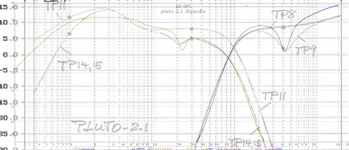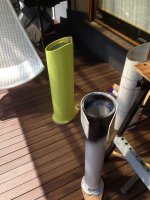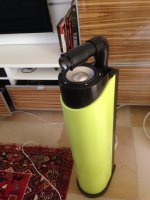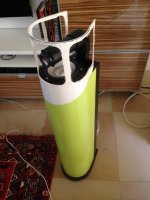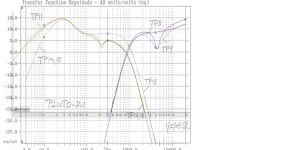Last few days I'm finding myself really stuck to my listening chair, what a great natural and relaxed sounding speakers are these! The overall soundstage is ridiculously bigger then physical size suggests!
First impressions
The treble sounds really sweet if recording is sweet, crisp if recording is crisp but always with lots of air, ambience and placement is really the best I've heared, the loudspeakers disappear fully - I'm not even missing my TNT Convertus minimalist DAC, which has no use now anymore. I hear more details then I knew of in my favourite recordings and all make sense!
Bass is fast and much deeper then I could even imagine for less then 7 l volume. I had an open-pipe system with double woofers before, the Pluto's are sounding more refined with no annoying room-interactions. This makes it more fun to listen to difficult recordings where basslines are suddenly appearing which I never heared before! All comes out effortless!
Where I started the Pluto project as a kind of exercise ("let's see...") they are here to stay!
Here's some of my music I listened to past days:
Tracy Chapman - Tracy Chapman
Roger Waters - Amused to Death
Chesky Collection
Chris Botti - Night Sessions
GRP - Sounds of 1994
Hatfields End - Stonehenge 4
Notting Hillbillies - Persumed having a good time
Sara K - Closer than they appear
Loreena McKennit - The Visit
Building
Electronics
Since I was already using active speakers, I did not want to replace my poweramps for the proposed integrated solution. I'm using a Rotel RB971 for the low-end and a DIY hybrid tube/mosfet class A PP amplifier for the high range.
For the active filter/equalisation, I decided to implement the original ASP design in miniDSP platform using IIR techniques (no FIR available yet for this platform). First because the "let's see..." approach, but the integrated DAC and processing sounds very good! The 4 DAC output stages are buffered in my DIY pre-amplifier using buffer stages of an older Pass SE class A design. There was enough space left in the casing to integrate the miniDSP/miniDIGI within this casing. 4-Channel volume control takes place in the 56 bit digital domain before 24 bit DAC's. Should be fine theoretically, but not to loose too much bits when playing at low volumes (18 dB attentuation loses 3 bits), I choose the gain for 0 dB attenuation as "a little too loud".
Unfortunately I have not heared Pluto's with the original ASP, but for now I can hardly imagine that all these opamps can do a better job then this big calculator...
Here's some pictures:

Simulated the 2.1 ASP to obtain frequency response in ASCII format
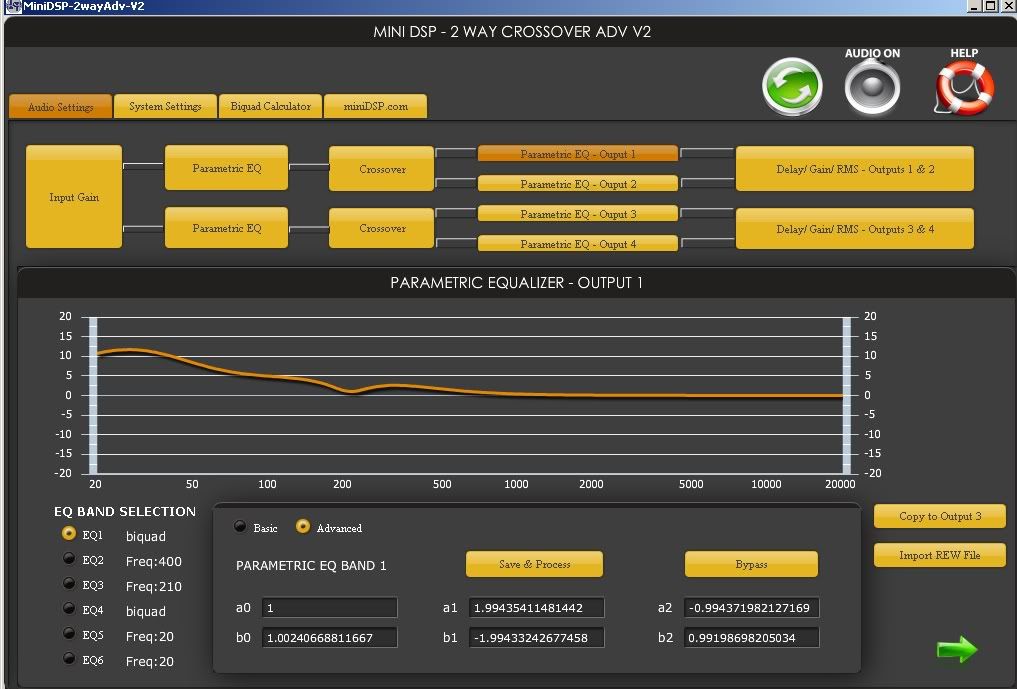
Digital implementation of ASP, LP section required 2 PEQ and 2 biquads
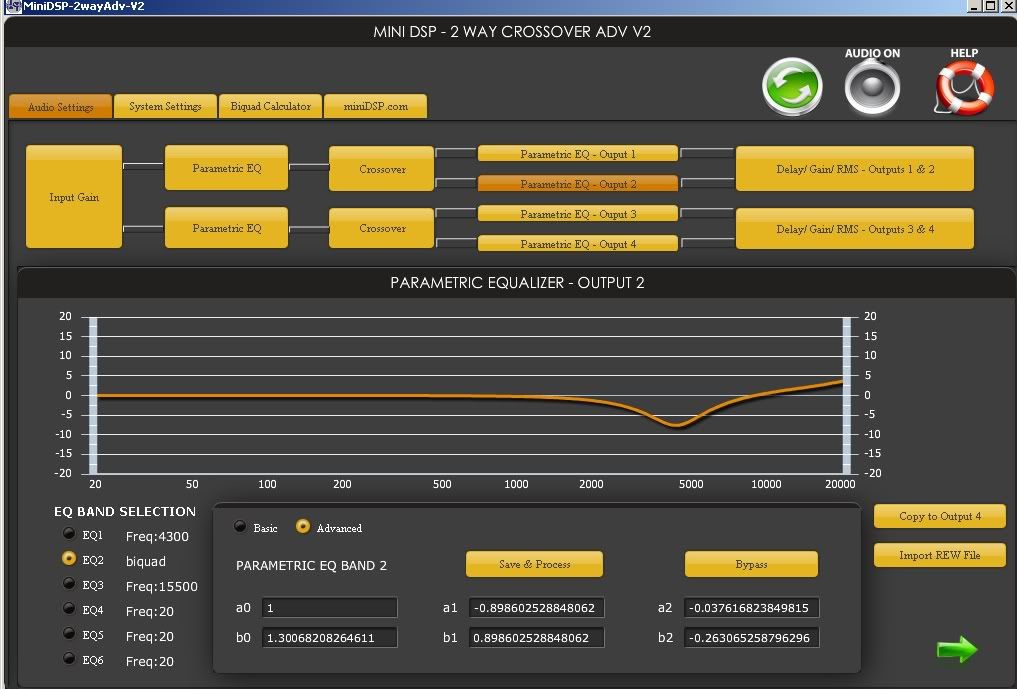
Digital implementation of ASP, HP section required 2 PEQ and 1 biquad. The delay circuit was implemented as a pure delay.

Tweaking frequency response. Green and purple line are target responses, blue line is actual HP achieved
Mechanical
Started as below:

Plywood bars to be epoxied on PVC pipe-coupler
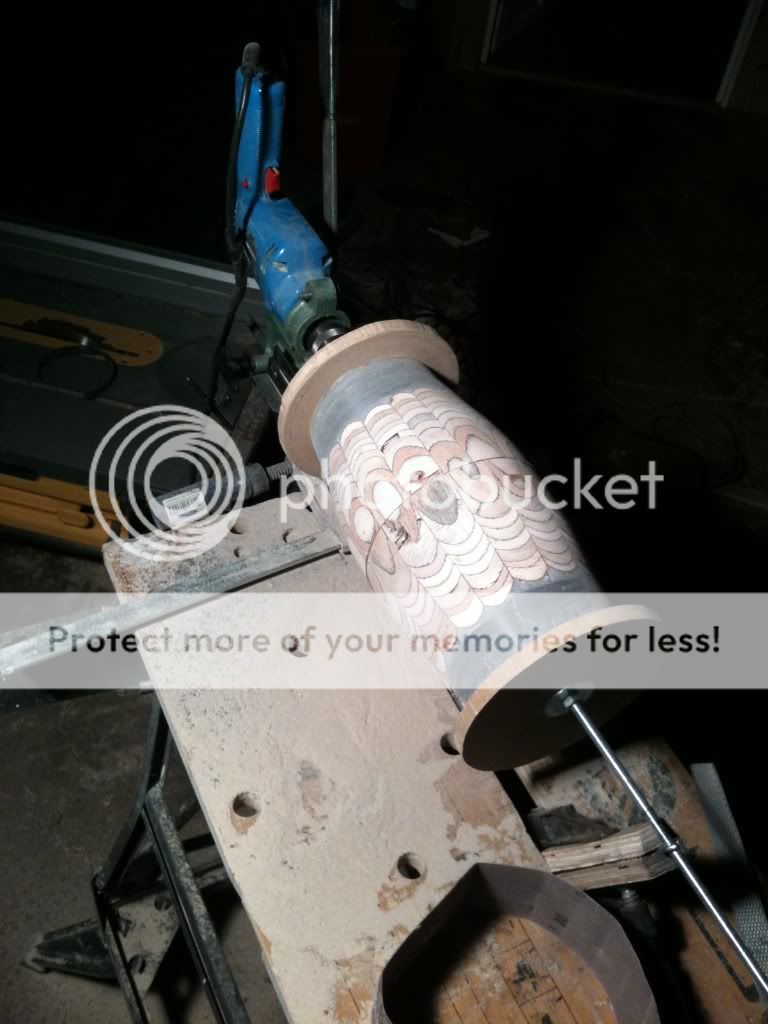
Quick-and-dirty turning lathe to get decent fairing
Unfortunately when finished, I put one of the woofers in and noticed the quite small gap between magnet and PVC coupler. I had recessed the woofer too much! With about 1 cm space around magnet I was afraid for compression effects.
As a second trail, I ordered 2 "Orchidea" flowerpots with quite good fit, but they appeared to be made eof polypropylene, not suitable for glueing, reinforcing etc! Damn! I used the flowerport as mold to laminate with GRP about 4 layers of laminate from the inside. The result was a very tight "Copy1_of_flowerpot":

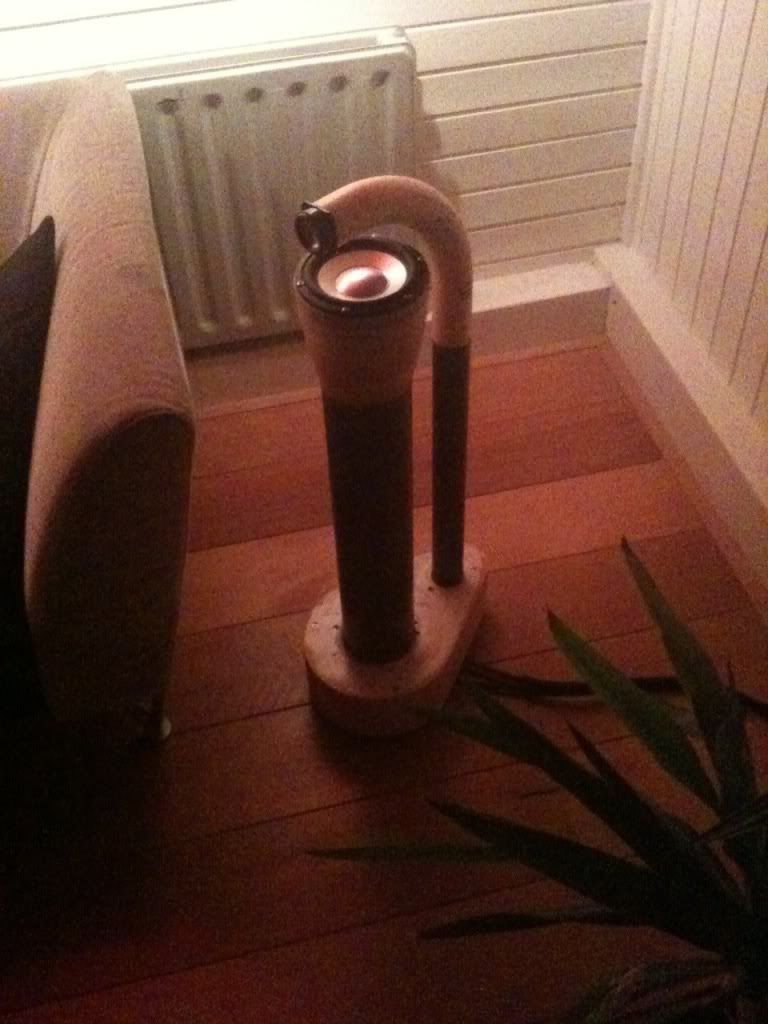
First listening!

Faired and painted

Finished!
Big thankx to you enthousiasts for challenging me and off course to mr. Linkwitz himself for providing understanding, explaining and proving how perception works!
A question finally:
On some female voices, at higher volumes I notice a slight coloration in the upper midrange. Not disturbing (at least for now), could this have to do with distortion of the Aura driver or maybe stuffing? Does anybody have experience with how much stuffing to use in the tweeter tube? Now is quite arbitrary because I found no clear guidelines, I would say I used a loose dot of 7 cm length some 2 cm behind the driver.
Kind regards,
Maarten
First impressions
The treble sounds really sweet if recording is sweet, crisp if recording is crisp but always with lots of air, ambience and placement is really the best I've heared, the loudspeakers disappear fully - I'm not even missing my TNT Convertus minimalist DAC, which has no use now anymore. I hear more details then I knew of in my favourite recordings and all make sense!
Bass is fast and much deeper then I could even imagine for less then 7 l volume. I had an open-pipe system with double woofers before, the Pluto's are sounding more refined with no annoying room-interactions. This makes it more fun to listen to difficult recordings where basslines are suddenly appearing which I never heared before! All comes out effortless!
Where I started the Pluto project as a kind of exercise ("let's see...") they are here to stay!
Here's some of my music I listened to past days:
Tracy Chapman - Tracy Chapman
Roger Waters - Amused to Death
Chesky Collection
Chris Botti - Night Sessions
GRP - Sounds of 1994
Hatfields End - Stonehenge 4
Notting Hillbillies - Persumed having a good time
Sara K - Closer than they appear
Loreena McKennit - The Visit
Building
Electronics
Since I was already using active speakers, I did not want to replace my poweramps for the proposed integrated solution. I'm using a Rotel RB971 for the low-end and a DIY hybrid tube/mosfet class A PP amplifier for the high range.
For the active filter/equalisation, I decided to implement the original ASP design in miniDSP platform using IIR techniques (no FIR available yet for this platform). First because the "let's see..." approach, but the integrated DAC and processing sounds very good! The 4 DAC output stages are buffered in my DIY pre-amplifier using buffer stages of an older Pass SE class A design. There was enough space left in the casing to integrate the miniDSP/miniDIGI within this casing. 4-Channel volume control takes place in the 56 bit digital domain before 24 bit DAC's. Should be fine theoretically, but not to loose too much bits when playing at low volumes (18 dB attentuation loses 3 bits), I choose the gain for 0 dB attenuation as "a little too loud".
Unfortunately I have not heared Pluto's with the original ASP, but for now I can hardly imagine that all these opamps can do a better job then this big calculator...
Here's some pictures:

Simulated the 2.1 ASP to obtain frequency response in ASCII format

Digital implementation of ASP, LP section required 2 PEQ and 2 biquads

Digital implementation of ASP, HP section required 2 PEQ and 1 biquad. The delay circuit was implemented as a pure delay.

Tweaking frequency response. Green and purple line are target responses, blue line is actual HP achieved
Mechanical
Started as below:

Plywood bars to be epoxied on PVC pipe-coupler

Quick-and-dirty turning lathe to get decent fairing
Unfortunately when finished, I put one of the woofers in and noticed the quite small gap between magnet and PVC coupler. I had recessed the woofer too much! With about 1 cm space around magnet I was afraid for compression effects.
As a second trail, I ordered 2 "Orchidea" flowerpots with quite good fit, but they appeared to be made eof polypropylene, not suitable for glueing, reinforcing etc! Damn! I used the flowerport as mold to laminate with GRP about 4 layers of laminate from the inside. The result was a very tight "Copy1_of_flowerpot":


First listening!

Faired and painted

Finished!
Big thankx to you enthousiasts for challenging me and off course to mr. Linkwitz himself for providing understanding, explaining and proving how perception works!
A question finally:
On some female voices, at higher volumes I notice a slight coloration in the upper midrange. Not disturbing (at least for now), could this have to do with distortion of the Aura driver or maybe stuffing? Does anybody have experience with how much stuffing to use in the tweeter tube? Now is quite arbitrary because I found no clear guidelines, I would say I used a loose dot of 7 cm length some 2 cm behind the driver.
Kind regards,
Maarten
Great project, Maarten!
Thanks for posting details - I'm getting inspired to try something similar.
I have a Behringer DEQ2496 and DCX2496- do you think I could implement something like your project using those?
Amps aren't a problem - I have a bunch.....😀
John
Thanks for posting details - I'm getting inspired to try something similar.
I have a Behringer DEQ2496 and DCX2496- do you think I could implement something like your project using those?
Amps aren't a problem - I have a bunch.....😀
John
Hi John,
Thanks.
I have no experience with your DSP's but guess that it should be possible. As long as it employs IIR, you should be fine with respect to phase behaviour.
I could almost reproduce every part of the ASP mathematically (and directly type-in miniDSP) except for the LP notch and LShelf, as there is no buffer opamp in between in the ASP so the combined transfer function of those is not a simple linear addition! For that reason I had to use a little trail&error to measure and compare the DSP with (PC simulated) ASP. miniDSP is very easy and flexible in that respect, in an hour on-line tweaking I as within 0.5 dB. Your DSP is probably also...
I am also interested to hear the difference with a phase-coherent Pluto using FIR (do not expect a lot of improvement intuitivily), but that would require a total new design of (particularly) the crossover and less for the equalisation. Can your DSP's utilise FIR?
Best regards,
Maarten
Thanks.
I have no experience with your DSP's but guess that it should be possible. As long as it employs IIR, you should be fine with respect to phase behaviour.
I could almost reproduce every part of the ASP mathematically (and directly type-in miniDSP) except for the LP notch and LShelf, as there is no buffer opamp in between in the ASP so the combined transfer function of those is not a simple linear addition! For that reason I had to use a little trail&error to measure and compare the DSP with (PC simulated) ASP. miniDSP is very easy and flexible in that respect, in an hour on-line tweaking I as within 0.5 dB. Your DSP is probably also...
I am also interested to hear the difference with a phase-coherent Pluto using FIR (do not expect a lot of improvement intuitivily), but that would require a total new design of (particularly) the crossover and less for the equalisation. Can your DSP's utilise FIR?
Best regards,
Maarten
Maarten, really nicely done, and thank you for posting it.
What did you use for the tweeter pipe? The bend looks very smooth, and much nicer than the couplers and elbows usually used.
What did you use for the tweeter pipe? The bend looks very smooth, and much nicer than the couplers and elbows usually used.
Thanks, they do mix quite nice in the interior indeed. The 90 degrees bends ars high-pressure pvc bends. Sometimes also known as "entrance bows" used to allow entering cabling into protective pvc piping surrounding them. I simply glued them to the straight piping section using acrylateglue (superglue or "second-glue"). This is as strong as the pvc itself as long as the joint is completely flat.
Regards, Maarten
Regards, Maarten
I've never used the Whisper in a long tube, but for automotive use I've found that it's useful to snip the bug screen and put a wad of polyfill right behind the diaphragm. That measureably helps with a ~2kHz resonance that could be the cause of the distortion you hear.
I just finished my Pluto's based on miniDSP. Could someone please post xml file for miniDSP application of ASP
Here:http://www.diyaudio.com/forums/minidsp/174145-minidsp-linkwitz-orion-asp-7.html
On the bottom of the page.
I had a problem with the EQ at 42 Hz.
Bernt
On the bottom of the page.
I had a problem with the EQ at 42 Hz.
Bernt
I used Seas.
Added a sub later.http://www.diyaudio.com/forums/multi-way/207478-pluto-clone-incl-sub.html
Bernt
Added a sub later.http://www.diyaudio.com/forums/multi-way/207478-pluto-clone-incl-sub.html
Bernt
Hi Bernt,
I see a problem with EQ all over. Have a look at attached plot: minidsp response based on your xml vs Linkwitz original drawing.
By the way, nice speaker you are working on, kind of Beolab 5.
Mine is still work in progress, currently working on grille.
cheers
qtanker
I see a problem with EQ all over. Have a look at attached plot: minidsp response based on your xml vs Linkwitz original drawing.
By the way, nice speaker you are working on, kind of Beolab 5.
Mine is still work in progress, currently working on grille.
cheers
qtanker
Attachments
Qtanker
I like your design too.
Do you place the Amp´s on the rear side?
You could send a PM to the treadstarter to get his XML.
Bernt
I like your design too.
Do you place the Amp´s on the rear side?
You could send a PM to the treadstarter to get his XML.
Bernt
Hi Bernt,
No, amp is not built in. But I think it can be fitted in the back in place where tweeter tube is. As I understand tweeter tube doesn't need to be that long.
I realised that minidsp was clipping when I made first measurement. Here it is again, your xml compared to Linkwitz plots.
cheers
No, amp is not built in. But I think it can be fitted in the back in place where tweeter tube is. As I understand tweeter tube doesn't need to be that long.
I realised that minidsp was clipping when I made first measurement. Here it is again, your xml compared to Linkwitz plots.
cheers
Attachments
- Status
- Not open for further replies.
- Home
- Loudspeakers
- Multi-Way
- Pluto DSP clones finished
